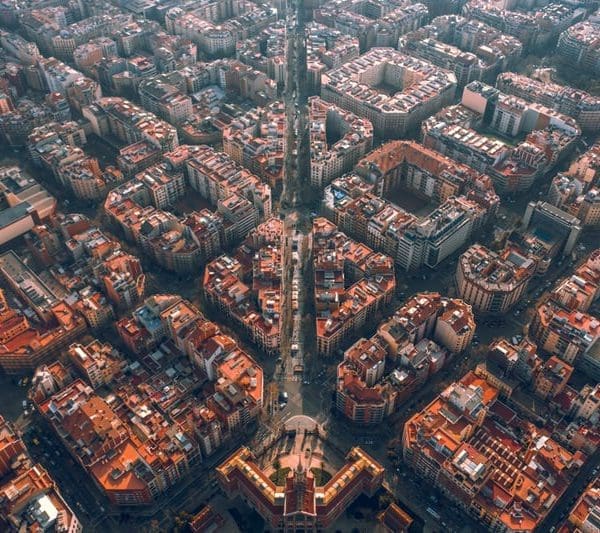Barcelona is a big city, spread over a large area with many different quarters. The public transport is excellent: buses, trams, and metros will help you get around.
Despite the fact that it’s the capital of its own independent territory – Catalonia – Barcelona is undoubtedly the biggest tourist destination in Spain. Not without good reason – the city plays host to some of Spain’s most impressive architecture, museums, parks and landmarks. Not to mention the awesome nightlife and food scene!
Location: Barcelona, Catalonia (Spain)
Language: Spanish/Catalan
Population of city: 6 Million
Nearest airport: Barcelona El Prat Airport, Girona-Costa Brava Airport
Main train/bus station(s): Barcelona Sants Station
Best time to visit? All year round, but July and August are very busy. Aim for May or September for a good balance of nice weather and fewer tourists.
Budget level? £££
Barcelona offers loads to see and do, and one visit is never going to be enough to see it all. Depending on where you’re coming from, you’ll want to plan at least 3 nights (you might get away with 2 if you’re travelling from nearby, e.g. Madrid) to get a good taste of the city. You could spend 5 or 6 nights if you want a more chilled-out beach break.

Talking about Barcelona without mentioning Antoni Gaudí’s work would be a shame. Part of the Catalan modernism artistic movement along with Salvador Dalí or Joan Miró, this renowned architect is behind six (out of eight!) of the points of interests declared World Heritage Sites by UNESCO in Barcelona:
Did you know the construction of Barcelona’s iconic basilica has yet to be completed? Yet, it still attracts up to 4 million visitors every year. The city hopes to have its construction finished by 2026, a century after its architect’s death. With its massive columns, beautiful stained glass, and decorated facades, the Sagrada Familia will take your breath away!
Built from 1900 to 1914, the park was entirely designed by Gaudí and became a public park in 1926. In the gardens you can enjoy a beautiful view of the city, pass by terrace walls imitating the trees that are planted on them, sit on serpentine benches decorated with colourful mosaics and snap pictures of “el drac,” a giant ceramic salamander that has now become the symbol of the park.
Commissioned by Eusebi Güell, the “palace” was one of Gaudí’s earliest works. Open to the public, you’ll be able to see for yourself Gaudí’s take at interior design, from the basement up to the rooftop and its unique, colourful chimneys.
Criticised and ridiculed at its time of construction, the building now attracts millions of visitors every year who come to admire Antoni Gaudí’s work. All five floors are open to the public and the tour will lead you up and down its corridors to see everything from the Whale Attic to the Tenant’s Apartment or the Flower and Butterfly courtyards.
The first house designed by Antoni Gaudí is considered to be the first building of Art Nouveau and is, as usual when it comes to Gaudí’s work, a mix of different architectural styles. This time, Gaudi took inspiration from the Mudéjar style; a style inherited from the 11th century that mixes European and Moorish cultures together.
Also known as the “House of Bones”, this house was completely redesigned and refurbished by Gaudi between 1904 and 1906. Nowadays, it is considered to be one of Gaudí’s masterpieces. Did you know the roof is meant to resemble a dragon’s back? You can observe the shimmering blue tiles from the street or decide to buy tickets to visit the inside of the house and its rooftop and see more of Antoni Gaudí’s ingenious and modern designs.
Barcelona is a big city, spread over a large area with many different quarters. The public transport is excellent: buses, trams, and metros will help you get around.
As the seafront neighbourhood, this part of Barca is where you’ll find chilled beach bars, touristy shops, and the marina with its glitzy yachts and supercars.
Barcelona’s oldest neighbourhood, with loads of bars, restaurants, and shops tucked away in tiny alleyways and winding cobbled streets.
Bohemian and trendy, El Born is home to boutiques and independent eateries. Head here for veggie and international food options, or unique gifts.
Hang out with young, artsy locals in this off-the-beaten-track area. Shop for local craft items and stroll around the elegant streets.
Starting from the Placa de Catalunya, La Rambla is the heart of the city centre and will lead you straight to the Columbus Monument in Port Vell. As you walk down this very long street (1.2 km), you’ll be able to see some cultural establishments, including Barcelona’s opera house (Gran Teatre del Liceu), the 18th-century Virreina Palace, or the Centre d’Art Santa Mònica, a contemporary art museum. If you’re paying close attention, you might even spot some of Joan Miro’s work on the pavement!
The hill of Montjuic overlooks Barcelona’s harbour and has been a strategic outpost since the creation of the city. On the hill you’ll find many gardens and the remnant of the Castle of Montjuic, a fortress from the 17th century. But if you love art and spending time in museums, you must go to the Palau Nacional. Home to the National Art Museum of Catalonia, the palace was originally built for the 1929 International Exhibition and now hosts an outstanding Romanesque collection.
Situated at the Barcelona Royal Shipyard at the end of La Rambla, the Museu Maritim stands as a reminder of Spain’s former naval supremacy. In this already impressive building, you’ll be able to learn about the history of the Spanish Navy from the 15th century until today. Highlights of this museum? The faithful replica of different jaw-dropping vessels, including a 60-meters-long medieval rowing galley. Right outside the museum, the three-mast schooner Santa Eulàlia in Port Vell is also worth the sight!